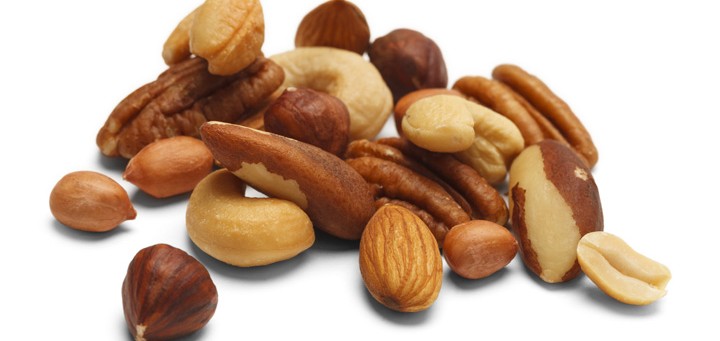
Truly Deeply Madly
Going Nutty
December, 2015
Good Things come in small packages. And nuts are Nature’s perfect example. Loaded with heart-healthy fats, fibre, vitamins, minerals and protein, nuts are a great addition to most diets. And while all nuts are equal is their zero-cholesterol goodness, each packs its own “super” punch. The key, however, to reaping those superfood benefits is to—for the most part—enjoy them dry roasted, unsalted or raw. Here’s some inspiration to get you crackin’.
Brazil nuts
Origin: The forests of Brazil, Bolivia and Peru are home to some of the longest-lived Brazil nut trees in the world.
Taste & Texture: Creamy and tender thanks to their high fat content, Brazil nuts go rancid quickly, so buy them in small quantities and store them in the fridge or freezer.
Nutritional Value: Toted as being good for men’s health, Brazil nuts are packed with selenium (a trace mineral that may protect against prostate cancer). They are also a good source of vitamin C and B-complex vitamins such as thiamine, riboflavin and folates. Like almonds, Brazil nuts don’t have gluten protein, which makes them a great choice for people with wheat-food allergies.
Add To: Brazil nuts are spectacular in brownies, but for an everyday-option, add them to rice, couscous and vegetable dishes.
Fun Fact: It’s believed that Brazil nut trees have a lifespan of up to 700 years!
Cashews
Origin: The cashew tree is native to Brazil’s Amazon rainforest and is cultivated commercially in Vietnam, India and many African countries.
Taste & Texture: These almost-addictive favourites are delicately sweet, with a firm yet buttery texture and a slightly sweet aroma.
Nutritional Value: Cashews pack a lot of protein and are a great addition to vegetarian diets. They are also high in copper, which your body uses to produce haemoglobin and collagen. They’re also a source of calcium, iron, magnesium, phosphorus, potassium, selenium, vitamin K and zinc.
Add To: Stir-fries, noodle bowls, curries, homemade caramel popcorn—any place you crave a buttery, rich crunch. Killer on homemade sundaes.
Fun Fact: The anacardic acid in cashews appears to increase our cells ability to absorb sugar, which decreases the amount of sugar in our bloodstream, thus helping us control our blood sugar.
Macadamia
Origin: Native to northeastern New South Wales and to central and southeastern Queensland, macadamia nuts also go by the name Australia nut, Queensland nut and bush nut.
Taste & Texture: Macadamia nuts have a sweet and silky taste and texture that is often described as “refreshing.”
Nutritional Value: A good source of monounsaturated fatty acids (the kind that benefit the cardiovascular system), manganese, plant sterols and fibre.
Add To: White chocolate macadamia nut cookies could (and possible should) be their own food group, but for everyday consumption, stick to eating them raw or toasted.
Fun Fact: Macadamia trees were first introduced to Hawaii as a windbreak for sugarcane. Today, Hawaii has more than 700 macadamia farms.
Pistachios
Origin: Archaeological evidence in Turkey suggests that people have been consuming pistachios since 7000 BC.
Taste & Texture: Pistachio nuts (which are actually seeds, as are cashews) have a sweet taste and buttery texture and are equally tasty salted or unsalted.
Nutritional Value: Pistachios are a good source of many antioxidant phyto-chemicals such as carotenes, which are believed to protect us from diseases and infections. The also contain vitamin B6, vitamin E, copper, iron, manganese and protein.
Add To: Pestos, stir-fries, and homemade granola are all made better with pistachios. For a little crunch in the morning, add a handful to your yogourt.
Fun Fact: Pistachios owe their green and purple hue to the antioxidants they contain.
Walnuts
Origin: Walnut trees are believed to originate in the mountain ranges of Central Asia or southern Europe.
Taste & Texture: Walnut oil has a nutty flavour and aroma that’s beautiful in salad dressings and baked goods. Walnut kernels (shelled walnuts) are quite sweet tasting but can quickly bitter as they age and turn rancid.
Nutritional Value: Besides heart-healthy omega-3 fats, walnuts contain high amounts of alpha linoleic acid (ALA), which studies suggest help heart arrhythmias. They’re also a good source of B-complex vitamins, vitamin E, calcium, copper, manganese and potassium.
Add To: Homemade pesto, pizza, salads and, of course, your favourite baked goods. Or whiz them in a food processor, and make your own walnut butter.
Fun Fact: Studies suggest that eating walnuts can help protect against the brain functioning decline that occurs with aging and is linked to improving memory.
Roasted or Raw?
Some experts say seeds lose nutrients when exposed to high temperatures. However, many people still prefer roasted seeds to raw. To have your seeds and eat them too, dry roast them at no higher than 170˚F for no longer than 20 minutes.
Image © pixelrobot / Dollar Photo Club











